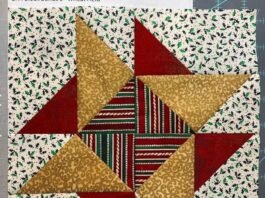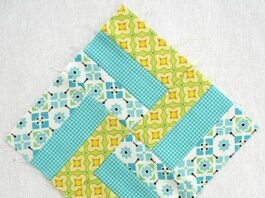The Churn Dasher Quilt Block is a timeless pattern that has been cherished by quilters for generations. Its simple yet striking design makes it a popular choice for both beginners and seasoned quilters.
In this blog post, we’ll walk you through everything you need to know about creating your own Churn Dasher Quilt Block, including fabric cuts and measurements.
Whether you’re looking for a charming addition to your quilt collection or a new project to try, this pattern is a perfect choice.

What is the Churn Dasher Quilt Block?
The Churn Dasher Quilt Block is a traditional pattern that dates back to the 19th century. It gets its name from the churn dasher, a tool used to churn butter, which the block’s shape resembles. The block is composed of a combination of squares, half-square triangles, and rectangles, which come together to create a dynamic visual effect.
This quilt block is known for its versatility. While it is traditionally made with two contrasting fabrics, modern quilters often experiment with bold colors and patterns to give the design a contemporary twist. Its simplicity allows for creativity, making it a favorite among those who love to play with fabric choices.
For those new to quilting, the Churn Dasher is an excellent starting point. It introduces basic quilting techniques like cutting, piecing, and assembling blocks, which are essential skills for any quilter. Plus, its geometric layout makes it easy to plan and execute.
Materials and Fabric Selection for the Churn Dasher Quilt Block
Before you start cutting and sewing, it’s important to gather the right materials. The Churn Dasher Quilt Block is typically made from two contrasting fabrics—one for the background and another for the churn dasher shape. The contrast between the two fabrics helps to emphasize the design and bring out the block’s charm.
For a standard-sized Churn Dasher Quilt Block (12 inches finished), you’ll need the following materials:
- Fabric A: Background fabric (light color, solid or low print)
- Fabric B: Churn dasher fabric (contrasting color, bold print or solid)
- Cutting tools (rotary cutter, cutting mat, ruler)
- Sewing machine and thread
- Iron and ironing board
When selecting your fabrics, think about how the colors will complement each other. Many quilters like to use a neutral background and a vibrant or patterned churn dasher fabric to make the block pop. For a more traditional look, consider using reproduction fabrics that mimic vintage designs.
Cutting the Fabric for Your Churn Dasher Quilt Block
The first step in creating your Churn Dasher Quilt Block is cutting the fabric according to the required measurements. Precision is key here, so take your time to ensure that your cuts are accurate. Here’s what you’ll need for a 12-inch finished block:
From Fabric A (background fabric):
- Two 4.5″ squares for half-square triangles
- Four 3.5″ x 6.5″ rectangles for the sides
- One 4.5″ square for the center
From Fabric B (churn dasher fabric):
- Two 4.5″ squares for half-square triangles
- Four 3.5″ x 6.5″ rectangles for the churn dasher arms
Make sure to press your fabrics before cutting to remove any wrinkles. Using a sharp rotary cutter and a clear ruler will help you achieve clean, precise cuts. Accuracy is important in quilting, as even small discrepancies can affect the final block assembly.
Piecing the Churn Dasher Quilt Block Together
Now that your fabric pieces are cut, it’s time to start piecing them together. Follow these steps to assemble the Churn Dasher Quilt Block:
Step 1: Creating Half-Square Triangles
Take the two 4.5″ squares from Fabric A and Fabric B. Place them right sides together and draw a diagonal line from one corner to the opposite corner. Sew a 1/4″ seam on both sides of the drawn line. After sewing, cut along the diagonal line and press the seams open. You’ll now have four half-square triangles.
Step 2: Assembling the Center Square
The center of the Churn Dasher block is made from the 4.5″ square of Fabric A. This square serves as the anchor for the design and adds balance to the overall block. Set it aside for now, as it will be joined with the other components later.
Step 3: Sewing the Rectangles
Next, take the four rectangles from Fabric A and Fabric B. Pair them up, placing one rectangle from each fabric right sides together. Sew along the long edge with a 1/4″ seam allowance. Press the seams toward the darker fabric. These rectangles will form the churn dasher “arms.”
Assembling the Churn Dasher Quilt Block
Once all your components are pieced, it’s time to lay out the block and sew it together. Arrange the half-square triangles, rectangles, and center square in a 3×3 grid. The half-square triangles should be placed in the corners, with the churn dasher arms forming a cross shape around the center square.
Step 1: Sewing the Rows
Start by sewing the pieces together row by row. Sew the units in the top row, middle row, and bottom row using a 1/4″ seam allowance. Be sure to press the seams in alternating directions for each row (press seams toward the outside in the top and bottom rows and toward the center in the middle row). This will help reduce bulk and ensure the seams nest together neatly when you join the rows.
Step 2: Joining the Rows
Once the rows are sewn, you can join them together. Pin the rows together, matching the seams, and sew with a 1/4″ seam allowance. Press the final seams open or to one side, depending on your preference. Now, your Churn Dasher Quilt Block is complete!
Step 3: Final Pressing
Give the entire block a good press with your iron to set the seams and smooth out any wrinkles. A well-pressed block will be easier to work with when it comes time to assemble your quilt.
Creative Variations and Tips for the Churn Dasher Quilt Block
The beauty of the Churn Dasher Quilt Block lies in its adaptability. While the traditional block is made with just two fabrics, don’t be afraid to experiment with color, prints, and textures to create a unique look. Try using scrappy fabrics for a more playful, modern take on the design, or mix in solids with patterns for added depth.
If you’re new to quilting, consider making several Churn Dasher blocks and joining them together to create a full quilt top. This block lends itself well to repetition, and the geometric layout creates a stunning visual effect when repeated across an entire quilt.
For a more advanced project, you could also experiment with resizing the Churn Dasher Quilt Block. By adjusting the measurements, you can create smaller or larger blocks to fit your design needs.
Mastering the Churn Dasher Quilt Block Pattern
The Churn Dasher Quilt Block is a fantastic project for quilters of all levels. Its simplicity makes it approachable for beginners, while its versatility allows more experienced quilters to get creative with their fabric choices and layouts. With the detailed step-by-step guide provided in this blog, you’re well on your way to mastering this classic quilt block pattern.
Whether you’re making a single block as part of a sampler quilt or creating an entire quilt top from Churn Dasher blocks, this pattern is sure to be a favorite in your quilting repertoire. So gather your materials, fire up your sewing machine, and enjoy the process of creating your very own Churn Dasher Quilt Block!





